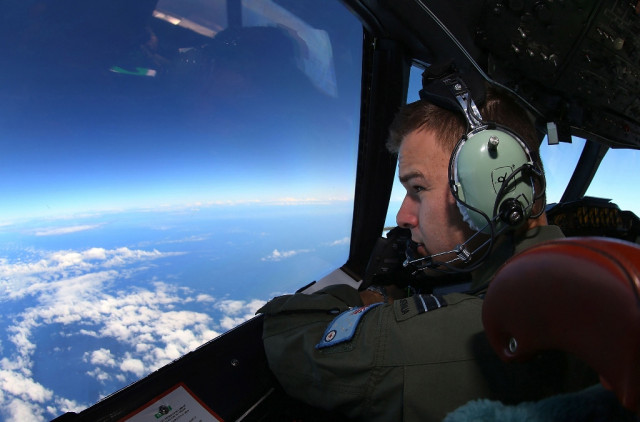Thai satellite finds 300 floating objects in jet search
Thunderstorms and gale-force winds ground the international air search for wreckage from Flight MH370.

Flight Lieutenant Russell Adams looks out from the cockpit of a Royal Australian Air Force (RAAF) AP-3C Orion aircraft while searching for the missing Malaysia Airlines Flight MH370 over the southern Indian Ocean March 26, 2014. PHOTO: REUTERS
The objects, ranging from two to 15 metres in size, were scattered over an area about 2,700 kilometres southwest of Perth, Anond Snidvongs, executive director of the Geo-Informatics and Space Technology Development Agency, told AFP.
But we cannot – dare not – confirm they are debris from the plane," the agency's executive director, Anond Snidvongs, told AFP.
He said the information had been given to Malaysia.
The pictures were taken by Thailand's only earth observation satellite on Monday but needed several days to process, Anond added.
He said the objects were spotted about 200 kilometres away from an area where French satellite images earlier showed potential objects in the search for the Boeing 777 which vanished on March 8 with 239 people aboard.
Thailand faced criticism after announcing more than a week after the jet's disappearance that its radar had picked up an "unknown aircraft" minutes after flight MH370 last transmitted its location.
The Thai air force said it did not report the findings earlier as the plane was not considered a threat.
The Malaysia Airlines plane is presumed to have crashed in the Indian Ocean after mysteriously diverting from its Kuala Lumpur-Beijing path and apparently flying for hours in the opposite direction.
Storms ground air search
Thunderstorms and gale-force winds grounded the international air search for wreckage from Flight MH370, frustrating the luckless effort yet again just as new satellite images of floating objects sparked hopes of a breakthrough.
It marked the second suspension within three days for the planes from several nations that, along with ships, have fought a losing battle against fierce winds and mountainous seas in the remote southern Indian Ocean as they hunt for hard evidence that the plane crashed.
"Today's search operations have been suspended due to bad weather," the Australian Maritime Safety Authority (AMSA), which is coordinating the search, said on its Twitter account.
The agency initially said ships were leaving the search area along with the planes, but later announced the ships would stay and try to continue the search.
"Bad weather expected for next 24 hours," it tweeted.
Malaysia had said late Wednesday that images taken in recent days by a French satellite showed "122 potential objects" adrift in the vast area, but nothing has been recovered yet that would confirm the plane's fate.
The Malaysia Airlines Boeing 777 is presumed to have crashed on March 8 in the Indian Ocean with 239 people aboard after mysteriously diverting from its Kuala Lumpur-Beijing path and apparently flying for hours in the opposite direction.
Malaysia believes the plane was deliberately re-directed by someone on board, but nothing else is known.
AMSA had said earlier the new satellite images were in an area authorities have pinpointed as a potential crash zone some 2,500 kilometres southwest of Perth.
Six military planes from Australia, China, Japan and the United States had been set to fly sorties throughout Thursday, along with five civil aircraft, scouring two areas covering a cumulative 78,000 square kilometres.
Five ships from Australia and China also were set to resume searching the zone.
The search was also suspended Tuesday due to bad weather, causing mounting concern as the clock ticks on the signal emitted by the plane's "black box" of flight data.
The data is considered vital to unravelling the flight's mystery but the signal, aimed at guiding searchers to the device on the seabed where it hopefully can be recovered, will expire in under two weeks.
The drama is playing out in a wild expanse of ocean described by Australian Prime Minister Tony Abbott as "about as close to nowhere as it's possible to be", and known for gale-force winds and towering waves.
The new satellite images provided by European aerospace giant Airbus depicted some objects as long as 23 metres, Malaysian Transport Minister Hishammuddin Hussein said.
Seeking closure, anguished families of those aboard are desperately awaiting hard evidence, which the aviation industry hopes can also provide clues to what caused one of aviation's greatest mysteries.
US law firm Ribbeck Law Chartered International fired the first salvo Wednesday in an expected barrage of lawsuits on behalf of grieving families. The firm is targeting Malaysia Airlines and Boeing.
"We are going to be filing the lawsuits for millions of dollars per each passenger based on prior cases that we have done involving crashes like this one," the firm's head of aviation litigation, Monica Kelly, told reporters in Kuala Lumpur.
A separate statement by the firm, which filed an initial court petition in the US state of Illinois on Tuesday, said the two companies "are responsible for the disaster of Flight MH370".
Malaysia Airlines has declined detailed comment.
Malaysia's government said this week that satellite data indicated the plane plunged into the sea, possibly after running out of fuel.
MH370 relatives have endured more than a fortnight of agonising uncertainty.
Two-thirds of the passengers were from China, and relatives there have criticised Malaysia in acid terms, accusing the government and airline of a cover-up and botching the response.
The sister of New Zealand victim Paul Weeks lashed out Thursday.
"The whole situation has been handled appallingly, incredibly insensitively," Sara Weeks told Radio Live in New Zealand.
"The Malaysian government, the airline, it's just all been incredibly poor."
Scores of Chinese relatives protested outside Malaysia's embassy in Beijing on Tuesday, and a day later Premier Li Keqiang urged Malaysia to involve "more Chinese experts" in the investigation.
While Malaysia believes the plane was deliberately diverted, other scenarios include a hijacking, pilot sabotage or a crisis that incapacitated the crew and left the plane to fly on auto-pilot until it ran out of fuel.
Focus has also been on the pilot, Captain Zaharie Ahmad Shah, with the FBI Wednesday saying it was close to completing an analysis of data from a flight simulator taken from his home.
Malaysian authorities had sought FBI help to recover files deleted from the hard drive.
So far, no information implicating the captain or anyone else has emerged.



















COMMENTS
Comments are moderated and generally will be posted if they are on-topic and not abusive.
For more information, please see our Comments FAQ